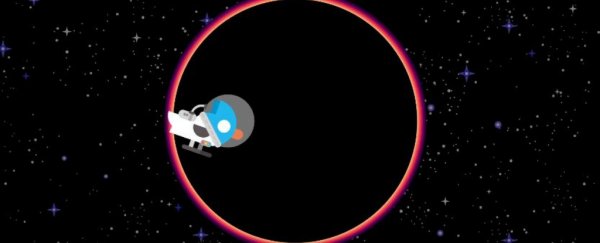
Black holes are weird. They're so weird, Stephen Hawking says that much of what we know about them is probably fundamentally wrong. What we do know is they have so much gravity, not even light can escape. And they can be as small as a single atom, but still have the mass of a mountain. They epitomise 'the fear of the unknown', but don't worry - we can all sleep a little easier with this video from design group, Kurzgesagt, which explains black holes from the birth until death.
So let's start by talking about suns, which are really just super-hot balls of mostly hydrogen collapsing through the sheer weight of their own gravity. This is known as nuclear fusion, and it occurs in the core, converting hydrogen to helium, and in larger suns, helium to carbon, carbon to neon and so on, making their way through the elements. Each of these changes causes a huge release of energy pushing against the gravity of the sun.
This creates equilibrium between the gravity and energy, and can go on for billions of years, releasing energy and light to nearby planets. Eventually though, the core creates iron, which doesn't release energy, so the energy to gravity equilibrium realigns.
If there is a build-up of iron, gravity becomes a stronger force then the release of energy. When this happens, the sun implodes, releasing mass back into the core and causing a supernova explosion. The outcome is either a neutron star or a black hole.
Now here is where it gets fun, because you can't actually see a black hole. Instead we see nothing, no stars, no reflections - even light is swallowed up.
The video above explains that when you look at a black hole, you will instead see the event horizon - the outside of the black hole. If you were to be sucked in beyond that, you'd have to be travelling faster than the speed of light to escape.
But having said that, black holes don't actually suck things up - they just swallow things that come into their path. For example, say our Sun turned into a black hole tomorrow. All of the planets in our Solar System would be safe from being sucked in by the dead Sun, but of course we'd still freeze to death without its warmth.
Although black holes may seem like a special occurrence, they're actually in the middle of every known galaxy, even ours. The largest black hole we know of is 40 billion times the mass of our Sun.
Black holes do eventually die due to a phenomenon known as hawking radiation, which is basically a build-up of quantum effects near the event horizon. But this takes a very long time, and everything else in the Universe is predicted to have completely disappeared before the last black hole dies.
Watch the video by Kurzgesagt above to find out what would happen if you were to fall into a black hole. Hint: it's nothing good.
